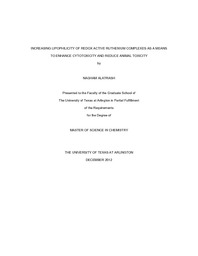| dc.description.abstract | The dinuclear and monomeric ruthenium(II) polypyridyl complexes [(phen)2Ru(tatpp)Ru(phen)2]Cl4 (P) and monomer [(phen)2Ru(tatpp)]Cl2 (MP) are promising candidates for anticancer drug development in terms of the observed anti-tumor activity in mouse models. These complexes contain the redox-active tatpp bridging ligand which seems to be the critical component for biological activity. Ruthenium complexes containing the tatpp ligand have been shown to cleave DNA with an inverse dependence on the [O2], exhibit selective and good cytotoxicity towards a number of cultured malignant cell lines, and have tolerable acute toxicity in mice. Significantly, the animal toxicity of P and MP is significantly less than simple ruthenium polypyridyl complexes, such as [Ru(1,10-phenanthroline)3]2+ which may be due to the enhanced lipophilicity of these complexes. This thesis is a direct test of the following hypothesis. We postulate that by increasing the lipophilicity of P and MP we can further mollify their acute toxicity and enhance their cytotoxicity towards malignant cancer cells. Chapters 1 and 2 of this thesis develop this hypothesis in terms of a review of the prior literature and our synthetic approach to construct such complexes. In Chapter 2, the details of the synthesis and characterization of four new lipophilic ruthenium-tatpp complexes based on the P and MP structures. These are (Ph2phen)2Ru(tatpp)Ru(Ph2phen)2][PF6]4 (PPh2), (Ph2phen, 4,7-diphenyl1-1,10-phenanthroline), [(Me4phen)2Ru(tatpp)Ru(Me4phen)2][PF6]4 (PMe4), (Me4phen, 3,4,7,8 tetramethyl-1,10-phenanthroline), [(Me4phen)2Ru(tatpp)][PF6]2 (MPMe4), [(Ph2phen)2Ru(tatpp)][PF6]2 (MPPh2). All of these can be metathesized to their chloride salt, which is the preferred form for water solubility and biological testing. Chapter 3 presents the effect of these structural changes on the biological activity of the novel complexes in terms of the maximum tolerable dose (MTD) observed in mice, the IC50 values against malignant cell line, H358, and the ability of these complexes to cleave DNA, in vitro. In order to quantify the increase in lipophilicity, the partition coefficients (log P) were determined for the ruthenium complexes via the shake-flask method in PBS at pH 7.4 and octanol as well as in deionized water and octanol. It was found that the lipophilicity of these complexes increased as the lipophilic ancillary ligands changes from phen to Ph2phen and Me4phen ligands. The ability of these complexes to cleave DNA was maintained even with these ligand modifications. The cytotoxicity study against H358 cell line have revealed that the most promising activity was shown by PMe4 and PPh2 with an IC50 value of about 10 μM. The lipophilic ruthenium complexes PPh2, PMe4, MPPh2, MPMe4 showed no acute animal toxicity in a screen of the MTD in Balb/c mice with doses up to 80 mg drug/Kg mouse. | en_US |


